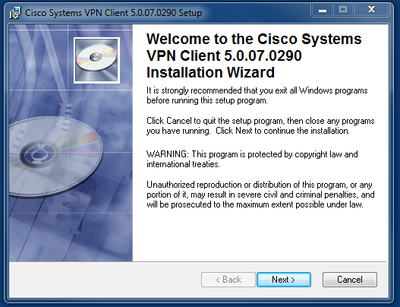
#Cisco vpn client pix how to#
I thought this was going to be a simple "oh yeah, turn this on" or "this isn't supported", but the TAC engineer who picked up my case just doesn't seem to grasp the concept, nor understand how to read my visio. The VPN connection establishes just fine from outside of either pix-c or pix-d. I should mention that the IPSec passthrough is enabled on both pix-c and pix-d. Then I tried at work, from behind a PIX which does not use NAT (pix-d) and got the same results. At first I thought it was due to NAT on my home PIX (pix-c). However, when attempting to connect to either of these two firewalls with the Cisco VPN Client when I am behind another PIX (like at a third site not attached to either pix-a or pix-b by any means of transport), the tunnel establishes, but I cannot pass traffic to the remote LAN. This also seems to work fine in most situations. I've also configured both of them to accept connections from Cisco VPN Clients for those folks who are on the road a lot. They are both connected via a static IPSec VPN. One in DC (pix-a) and one in San Diego (pix-b). I have a client who has two PIX 501 firewalls. Vpngroup HF default-domain ĭhcpd address 192.168.1.127-192.168.1.I seem to have baffled TAC with this question: Isakmp policy 20 authentication pre-share Timeout h323 0:05:00 mgcp 0:05:00 sip 0:30:00 sip_media 0:02:00Ĭrypto ipsec transform-set ESP-3DES-MD5 esp-3des esp-md5-hmacĬrypto ipsec transform-set ESP-DES-MD5 esp-des esp-md5-hmacĬrypto ipsec transform-set ESP-AES-MD5 esp-aes esp-md5-hmacĬrypto ipsec transform-set ESP-AES-256 esp-aes-256 esp-sha-hmacĬrypto dynamic-map outside_dyn_map 20 set transform-set ESP-AES-256Ĭrypto map outside_map 20 ipsec-isakmp dynamic outside_dyn_mapĬrypto map outside_map client authentication LOCAL Nat (inside) 0 access-list inside_outbound_nat0_acl Thank you for reading.Īccess-list inside_outbound_nat0_acl permit ip 192.168.1.0 255.255.255.0 192.168.2.0 255.255.255.0Īccess-list 100 permit icmp any any echo-replyĪccess-list 100 permit icmp any any time-exceededĪccess-list 100 permit icmp any any unreachable Any suggestions or advice are appreciated. I have seen problems similar to this posted several times but never a solution.
/Cisco-AnyConnect-Secure-Mobility-Client-56a1adbd5f9b58b7d0c1a21d.png)
Debug output from the Pix and logs from both versions of the VPN client available upon request. The Pix configuration is included with some addresses and identification changed or removed. All of these configurations produce the same result at both clients even when using the wizard configuration (the wizard's configuration fails to negotiate a transform during the ISAKMP phase). The main difference between these documents (and the wizard configuration) seems to be the selections for the ipsec transform set. How to Configure the Cisco VPN Client to PIX with AES-Cisco VPN Client: Ĭonfiguring Cisco Secure PIX Firewall 6.0 and Cisco VPN 3000 Clients Using IPSec-IPSec: Since then the configuration has been modified to match these two documents: The Pix was initially configured using the VPN wizard in the PDM. This has also been tried over a DSL connection with exactly the same result.

#Cisco vpn client pix Pc#
Both the outside port of the Pix and the PC running the client are on the same network so there should be no routing/DSL/modem issues. The client claims that it has lost contact with the security gateway (check your network connection). The clients are able to connect to the Pix, go through authentication, the client claims that the secure tunnel has been established and then 5 seconds later the tunnel is disconnected. I am running a Pix 501 (version 6.3(1)) and using the VPN Client (versions 3.6.4(a) and 4.0.1(Rel)) for VPN access.


 0 kommentar(er)
0 kommentar(er)
